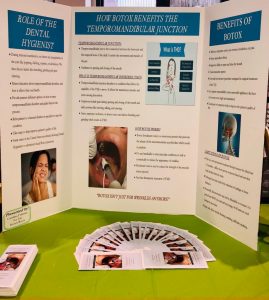Oral Pathology – Florid Osseous Dysplasia
Florid osseous dysplasia is a condition that occurs in the bones of the jaws and may present in multiple quadrants of the mouth. Lesions are typically symmetrical and often found in equal numbers and size on both sides of the jaws. Usually, a person is unaware of the condition until they visit a dentist for a routine dental examination and are diagnosed with radiographs.
This research project helped me realize that some patients may present with conditions that can affect their oral health and they may not be aware of it. Therefore, as a clinician, I should be aware of such conditions so I can effectively manage patients with these cases
I was fortunate during my third semester of Dental Hygiene to have seen a patient with florid osseous dysplasia. After exposing radiographs, the professor and I together were able to diagnose the florid osseous dysplasia and provide appropriate information to the patient who was unaware of their condition.
Click here in order to see the complete research paper.

Table Clinic – How Botox benefits the temporomandibular Junction
In this research paper, we investigated the many problems related to dysfunction of the TMJ and possible treatments. We talked about the benefits and limitations of Botox when used for the treatment of temporomandibular disorders. This research paper helped me realize that dentistry is a field that is always evolving, and as clinicians, we need to remain informed of new treatments to provide the best possible care.
Click here to see the complete brochure made for this presentation
Pharmacology – Barberry
In our Pharmacology class we learned about the different types of drugs that we will be considering in our career as Dental Hygienists. I found it interesting that people still use many herbs and supplements for medical use, even when though they are not approved by the Federal Drug Administration (FDA). It was eye-opening for me to learn that several cultures still use herbs as medications, and I was happy to learn about the most commonly used ones because I will most likely encounter patients who consume any of these supplements. My knowledge of the medicinal use of herbs will make me a better clinician.
I was assigned to research the herb Barberry, which grows in Asia and Europe, and is a well-known herb used in Iran. The barberry is an evergreen shrub plant with thorny gray branches that possess yellow spiny angled bark, elliptical leaves, yellow and red flowers, and oblong fruits. The fruit, bark, and roots of barberry are used for making medicines to treat conditions, such as dyslipidemia, central nervous system, cardiovascular, gastrointestinal, endocrine, and renal problems. The barberry also acts as an immunomodulator and anti-microbial agent.
Click here to see the complete research about Barberry
Histology & Embryology – Exostoses, Mandibular and palatal torus
During my first semester of Dental hygiene, in my Histology & Embryology class, I had the chance to present to my class and teach them about normal variations in the oral cavity. My topic was Exostoses, and mandibular and palatal torus, which are normal bony projections that can be found in the oral cavity.
Presenting to the class was a very interesting project for me because I was not familiar with any of these variations of the oral cavity, and I think it is important to know about them and recognize when these variations can affect the patient’s oral health.
Click here to see the complete presentation
Radiology – Calculus
For my Radiology class, we were given topics to research and explain how it would appear on a dental radiograph. My topic was one the most common mouth manifestations that occurs when a person is not taking care of their teeth, calculus.
I took Radiology in my second semester, when I was still becoming familiar with the terminology. Although, I and my classmates understood what calculus was at the time, many of us in the class were unfamiliar with how it appears on a radiograph. So, for me, the topic of calculus was very exciting to present to the class since some students in the class did not know how to recognize it on a dental radiograph, I was able to teach them.
Click here to see the complete presentation





